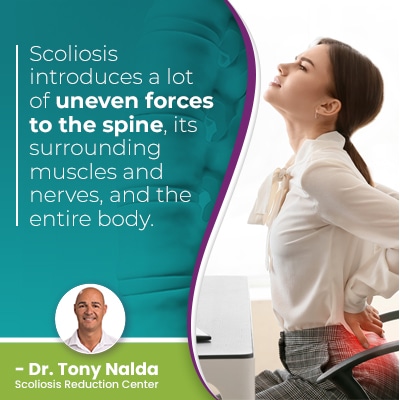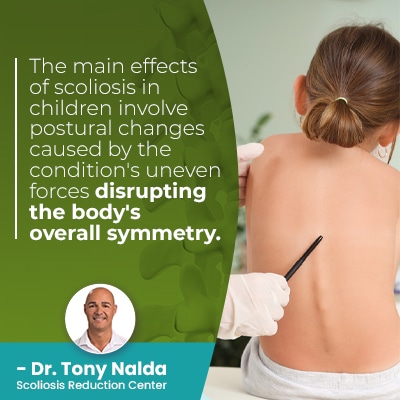What Can Scoliosis Do to You? Health and Physical Impact

No two cases of scoliosis are the same. Not only can scoliosis range widely in severity, there are also multiple different types of scoliosis, with different effects and treatment needs. The best way to minimize the effects of scoliosis is to treat it proactively; continue reading to learn how.
Scoliosis is a spinal condition, but it can affect the body in multiple ways. The main effect in children involves postural changes, and for adults, it's postural changes and pain. If left untreated, scoliosis can cause complications from digestive issues to lung impairment.
Scoliosis can become severe, but it can be highly treatable, particularly with early detection and intervention.
Table of Contents
Understanding Scoliosis
Scoliosis causes an unnatural sideways curve of the spine that also rotates, making it a 3-dimensional condition.
 Scoliosis introduces a lot of uneven forces to the spine, its surrounding muscles and nerves, and the entire body.
Scoliosis introduces a lot of uneven forces to the spine, its surrounding muscles and nerves, and the entire body.
The spine's healthy and natural curves make it stronger, more flexible, and better able to handle mechanical stress incurred during activity.
Scoliosis causes a loss of the spine's healthy curves due to the development of an unhealthy curve.
The spine has three main sections, and scoliosis can develop in any one section, or in more than one as a combined scoliosis: cervical spine (neck), the thoracic spine (middle/upper back), and the lumbar spine (lower back).
As a progressive condition, the nature of scoliosis is to get worse over time, and scoliosis progression is triggered by growth.
Scoliosis is Progressive
As a progressive condition, scoliosis is incurable, but it can be highly treatable, so scoliosis treatment is about how best to manage an ongoing condition for the best quality of life.
Because it's progressive, scoliosis isn't a static condition, it will always be changing, particularly for children.
In the majority of cases, we don't know what triggers scoliosis to develop initially, but we know that it's growth that triggers it to get worse, which is why childhood scoliosis should always be taken seriously.
The effects of scoliosis can change over time based on how the condition is progressing.
Of all the types of scoliosis, the most prevalent is also the most at risk for rapid progression: adolescent idiopathic scoliosis, diagnosed between the ages of 10 and 18.
Patients can minimize the effects of scoliosis by treating it proactively, but before we get to treatment options, let's talk about common condition effects.
Symptoms of Childhood Scoliosis
As a child grows, their scoliosis can get more severe, and this means the condition's effects are going to become more noticeable.
The main effects of scoliosis in children involve postural changes caused by the condition's uneven forces disrupting the body's overall symmetry.
Postural changes caused by children can include:
- Head appearing uncentered over the torso
- An uneven eye line
- Uneven shoulders
- Uneven shoulder blades
- The development of a rib cage arch
- Uneven hips
- Uneven waist line
- Arms and legs that hang at different lengths
Additional effects include disruptions to balance, coordination, and gait.
So any of the aforementioned effects of scoliosis can become more overt and severe over time if progression is occurring.
For adults, the main condition effect differs.
Adult Scoliosis Effects
 While adults will also experience postural changes alongside progression, the main effect is different because scoliosis becomes compressive once skeletal maturity has been reached.
While adults will also experience postural changes alongside progression, the main effect is different because scoliosis becomes compressive once skeletal maturity has been reached.
Once growth stops, the spine is no longer being constantly lengthened, so the spine and its surrounding muscles and nerves become vulnerable to compression; compression is the main cause of condition-related pain.
Compression is uneven pressure, and once scoliosis becomes compressive, it can become painful.
Scoliosis pain can involve back pain, muscle pain, and pain that radiates into the extremities due to nerve compression.
So the main effect of adult scoliosis that brings patients in for a diagnosis and treatment is scoliosis pain, whereas in children, it's postural changes.
Adult scoliosis effects will also get worse alongside progression, and the more a condition progresses, the more unstable and unbalanced the spine will become.
And what about the condition's effects if left untreated?
Scoliosis Complications
If scoliosis is left untreated, or not treated proactively, it can continue to get worse and develop complications, and the more severe scoliosis becomes, the more likely it is to continue progressing.
When severe, scoliosis can cause digestive issues, lung impairment, headaches/migraines, and sleep problems.
Although scoliosis is progressive, it can be highly treatable, but without treatment, the condition's nature is to get increasingly worse.
When particularly severe, digestive issues can develop due to structural changes within the spine that disrupt brain-body communication, and this affects organs, nerves, and muscles: all involved in digestion.
Lung impairment can develop in severe and very severe cases as an unnatural spinal curve in the thoracic spine can disrupt the position of the rib cage, leaving less room for the lungs to function optimally within.
While not a common complication, lung impairment is a risk, particularly for parents who place higher than average demands on their respiratory systems like long-distance runners and professional athletes.
Headaches and migraines can occur due to a disruption in the flow of cerebrospinal fluid in and around the brain.
Sleep problems are more likely as scoliosis progresses, particularly for adults for whom the condition is compressive and painful.
Scoliosis pain can make it difficult to get comfortable, to find a good sleep position, but scoliosis pain can be improved and managed through proactive treatment that addresses its underlying cause: the condition itself.
Scoliosis Treatment: Taking Control
It can be difficult to be diagnosed with a progressive spinal condition.
Many patients feel they have lost control over their own bodies and lives, but patients still have power and can regain control over their bodies through facing scoliosis head on: with proactive treatment.
Following a diagnosis, the most important decision to be made is how to treat conditions moving forward; this is important because different types of treatment will affect the spine differently.
How scoliosis is treated will shape the spine's long-term health and function.
Patients need to be aware of all treatment options available to them so they can make informed treatment choices, and the two main treatment approaches to choose between are surgical and nonsurgical.
Surgical Treatment: Spinal Fusion Surgery
Surgical treatment involves a type of spinal fusion.
Spinal fusion is a risky and invasive spinal surgery that comes with some serious potential complications and side effects.
Spinal fusion fuses the curve's most-tilted vertebrae into one solid bone so they can't become more unnaturally tilted over time, and metal rods are commonly attached to the spine with pedicle screws to hold the spine in place.
Spinal fusion can result in a straighter spine, but many patients suffer from an increase in back pain, particularly at the fusion site, and a noticeable loss in spinal flexibility and range of motion that impacts overall quality of life.
So in some cases, the effects of scoliosis treatment aren't all positive.
The reality, however, is that not all cases of scoliosis need surgery, and modern conservative treatment offers a nonsurgical alternative.
Conservative Treatment: Chiropractic-Centered
Here at the Scoliosis Reduction Center®, patients benefit from a proactive conservative treatment approach that strives to preserve as much of the spine's natural strength and function as possible.
Conservative treatment is noninvasive because it's natural and doesn't involve surgical intervention.
Conservative treatment is integrative, so combines the power of multiple scoliosis-specific types of treatment so conditions can be impacted on every level.
Chiropractic care can impact the condition's underlying structural nature by working towards a manual adjustment that realigns the spine.
Physical therapy and scoliosis exercises can help increase core strength for more spinal support and stability, to improve muscle symmetry, posture, and to activate specific areas of the brain from improved brain-body communication and body positioning.
Corrective bracing can help augment corrective treatment results by pushing the spine into a corrective position, and rehabilitation can involve the prescription of a series of custom-prescribed home exercises to further stabilize and heal the spine.
Conservative treatment is proactive because it's started as close to the time of diagnosis as possible and it works towards preventing progression, increasing condition severity, effects, and the need for invasive surgical treatment in the future.
Scoliosis effects can be manageable with treatment, but the type of treatment applied is key, along with when it's applied; with progressive conditions like scoliosis, the best time to start treatment is always now.
Conclusion
Scoliosis is a spinal condition that introduces a lot of uneven forces to the entire body, so its effects can be widespread.
In addition, the brain and spine work together to form the body's central nervous system, and the central nervous system is involved in the function of virtually every part and working system within the body.
There are also the psychological effects of being diagnosed with a progressive spinal condition that can't be discounted, and particularly for adolescents and young patients, negative body image issues are a concern as postural changes occur.
Scoliosis can range in severity from mild scoliosis to moderate scoliosis, severe and very severe scoliosis, and scoliosis symptoms become more overt the more severe scoliosis is.
The main types of scoliosis are idiopathic scoliosis, neuromuscular scoliosis, degenerative scoliosis, and congenital scoliosis, and regardless of severity or type, scoliosis treatment can often make improvements by minimizing the condition's effects.
Scoliosis surgery is also known to have some negative effects, and a fused spine is weaker and more vulnerable to injury, which can have further psychological effects; some patients are fearful of trying new things or participating in once-loved activities after the spine is fused.
Scoliosis can affect a patient's physical and mental health, and the best way to minimize the effects is to treat it proactively.
Dr. Tony Nalda
DOCTOR OF CHIROPRACTIC
After receiving an undergraduate degree in psychology and his Doctorate of Chiropractic from Life University, Dr. Nalda settled in Celebration, Florida and proceeded to build one of Central Florida’s most successful chiropractic clinics.
His experience with patients suffering from scoliosis, and the confusion and frustration they faced, led him to seek a specialty in scoliosis care. In 2006 he completed his Intensive Care Certification from CLEAR Institute, a leading scoliosis educational and certification center.
About Dr. Tony Nalda
 Ready to explore scoliosis treatment? Contact Us Now
Ready to explore scoliosis treatment? Contact Us Now





